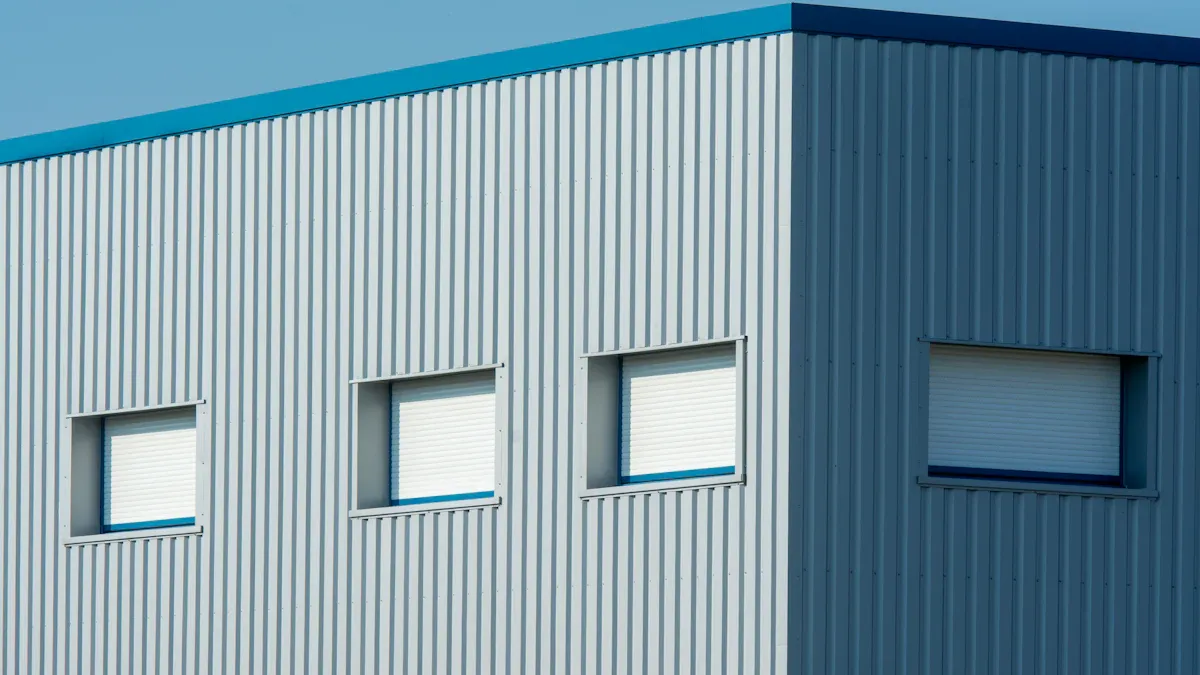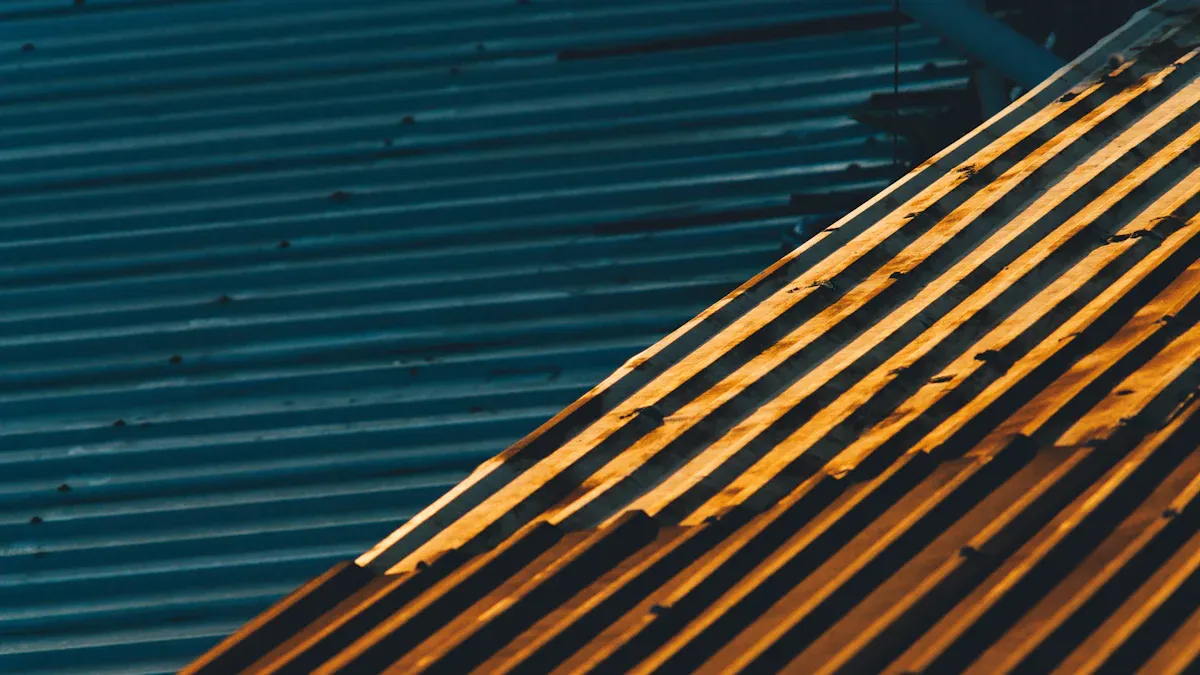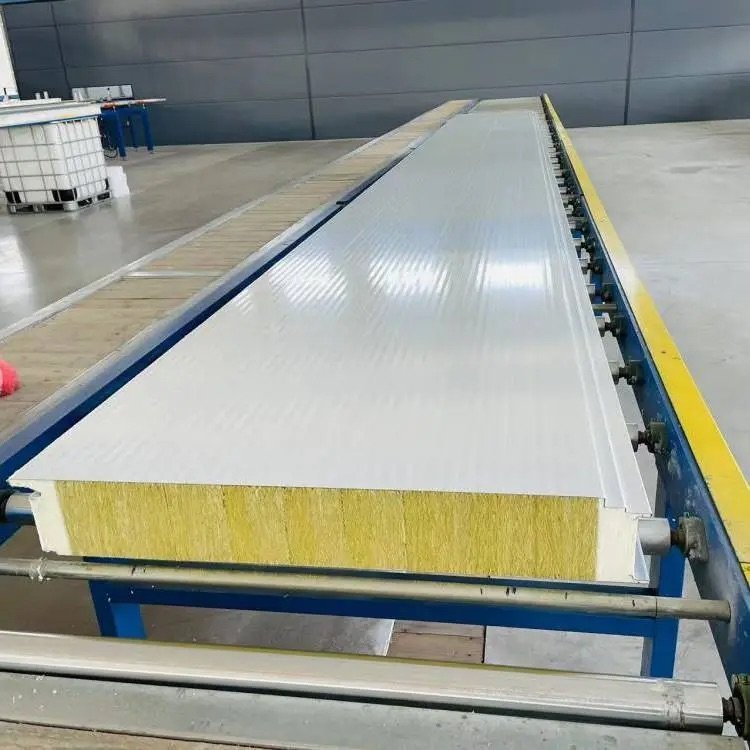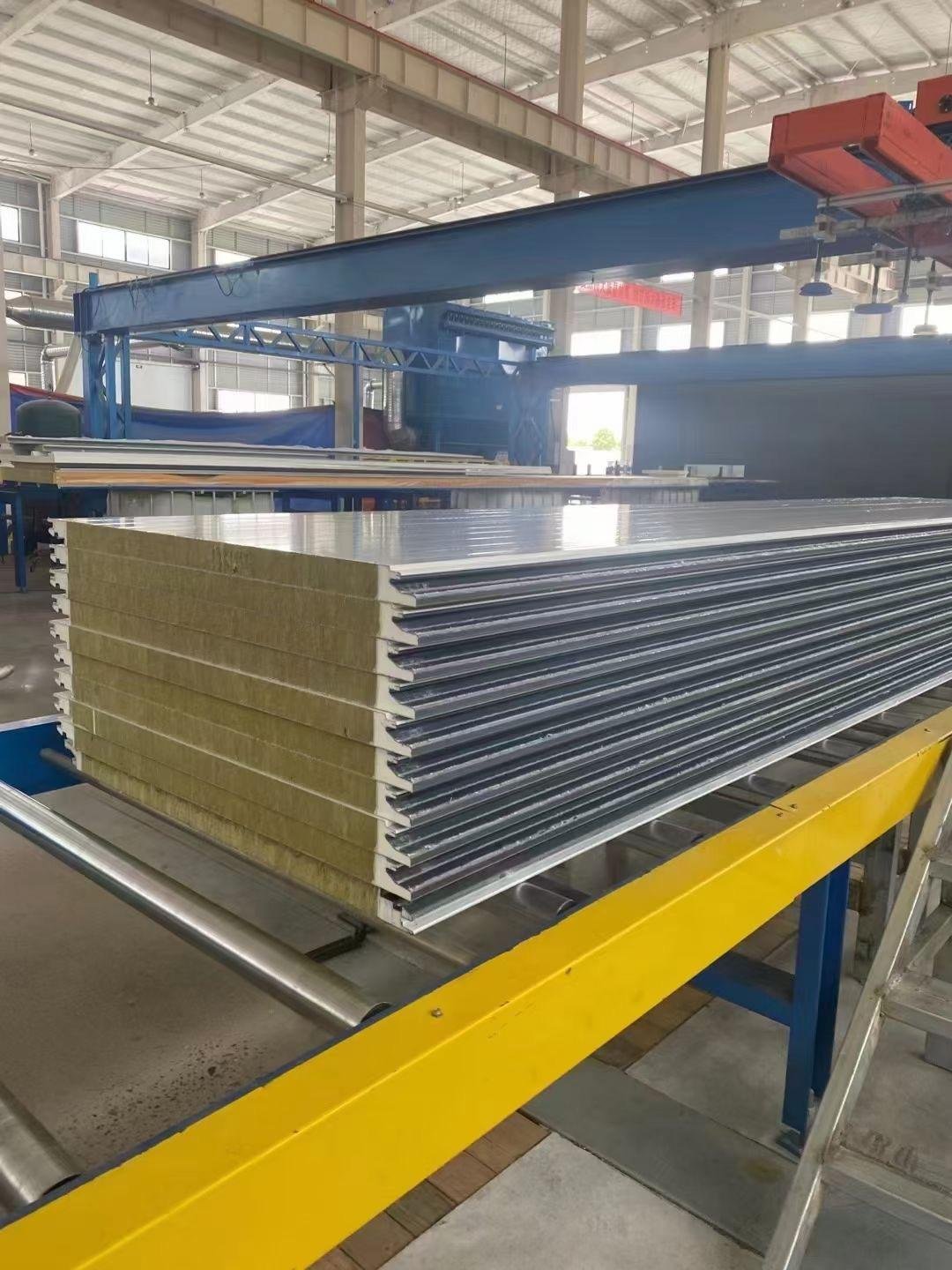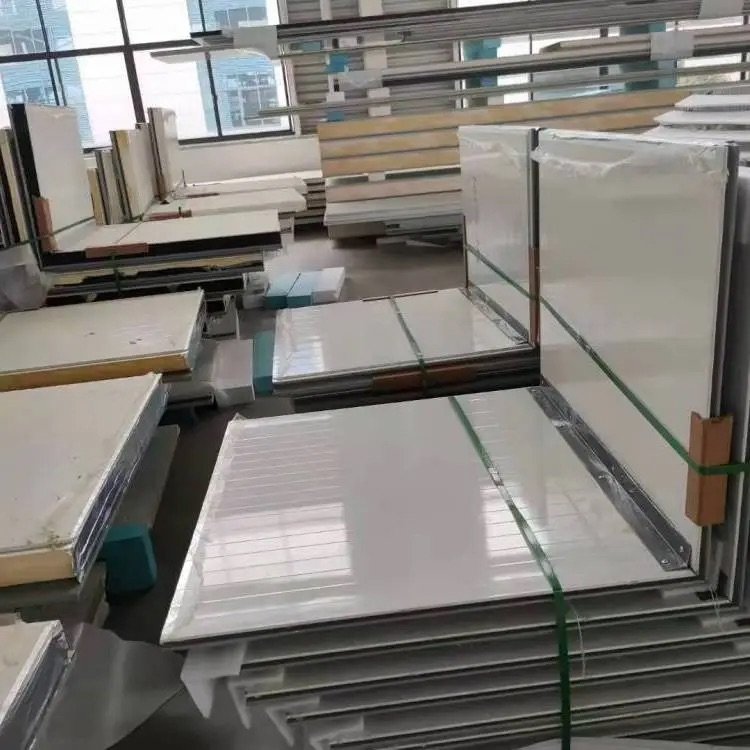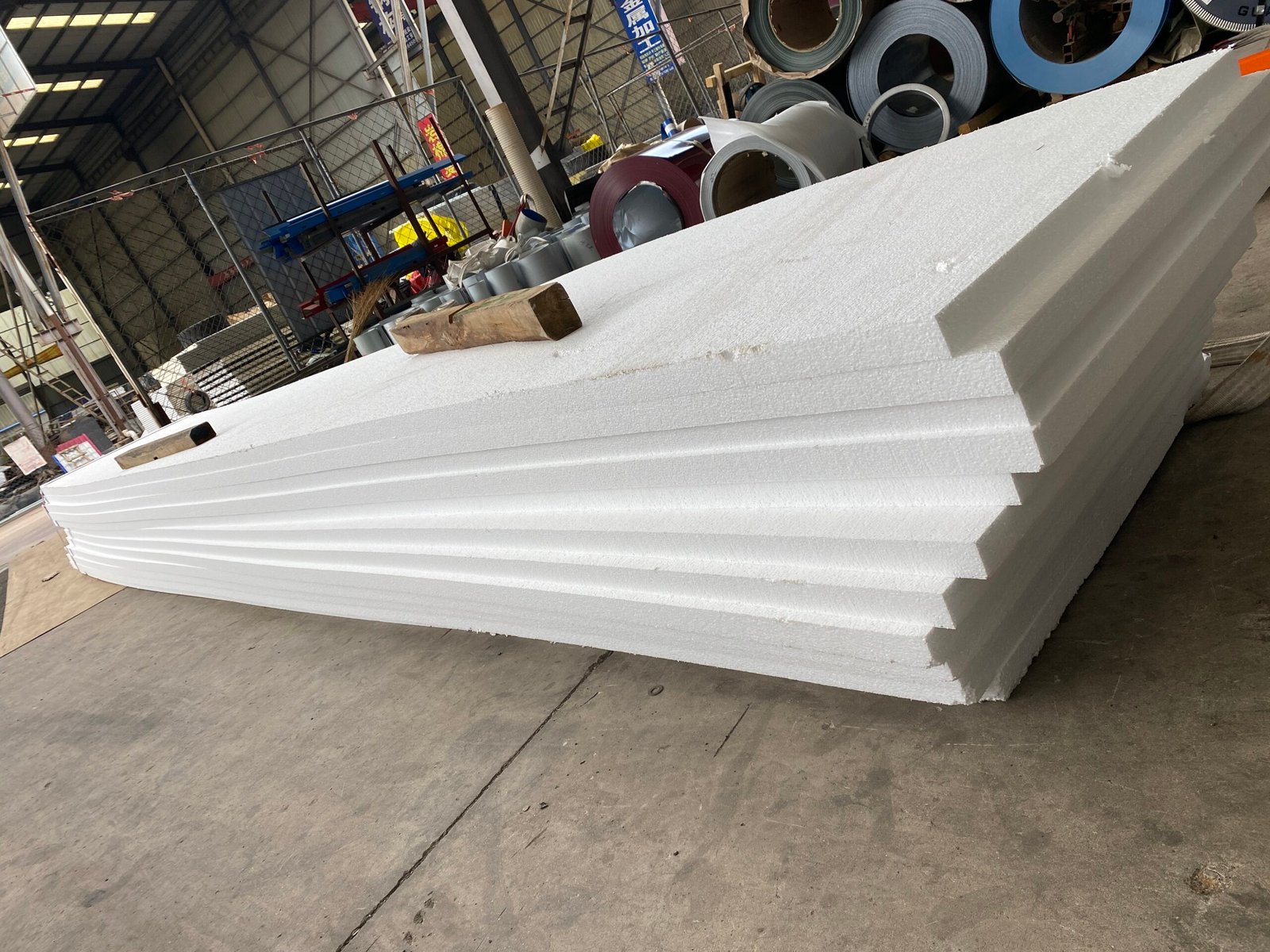
Choosing the right roof materials isn’t just about looks. It’s also about how well they work. Roof sandwich panels are made to handle heat and bad weather. Why is this important? Let’s explain:
Cities and industries need strong sandwich panels for building projects.
These panels keep spaces like cold storage at the right temperature.
Materials like polyurethane (PU) and polyisocyanurate (PIR) can handle tough weather.
Whether it’s hot summers or heavy rain, sandwich panels protect your building.
Key Takeaways
Pick the right roof panel for your weather. PIR panels are great for hot places, while XPS panels work best in wet areas.
Think about saving energy when choosing materials. PU and PIR panels lower heating and cooling costs, which saves money.
Choose materials that are safe and resist fire. Mineral wool panels are good because they don’t burn easily and make less smoke in emergencies.
Use lightweight panels for easy setup. Sandwich panels are simple to carry and install, saving time and effort.
Go for eco-friendly panels to help the planet. Many panels are made from recycled stuff and use less energy.
Top Roof Sandwich Panel Materials for Heat and Weather Resistance

Polyurethane (PU) Panels
Polyurethane (PU) panels are great for insulation and strength. They help keep buildings cool in summer and warm in winter. These panels are light, so they’re easy to install. PU panels also block moisture, making them last longer.
A study by Sharma and Kumar (2023) showed PU panels mixed with coconut husk work well. This mix improves insulation and helps the environment. PU panels are good for warehouses and homes. They protect against heat, cold, and rain.
Polyisocyanurate (PIR) Panels
Polyisocyanurate (PIR) panels give even better insulation than PU panels. They save energy by stopping heat from escaping through the roof. PIR panels help lower energy bills and keep spaces comfy.
More people want energy-saving buildings, so PIR panels are popular. They meet fire safety rules and are safe to use. Their light weight makes them simple to install.
PIR panel benefits include:
Lower energy use and fewer carbon emissions.
Fire safety compliance.
Mineral Wool Panels
Mineral wool panels are good for insulation and fire safety. They’re made from recycled or natural materials, so they’re eco-friendly. These panels also reduce noise, which is helpful in busy areas.
Studies show mineral wool panels stay effective in tough conditions. But moisture can make them wear out faster. Proper setup and care are important for long use.
For flat roofs or noisy places, mineral wool panels work well. They provide insulation and soundproofing for lasting performance.
Expanded Polystyrene (EPS) Panels
Expanded Polystyrene (EPS) panels are lightweight and insulate well. They are made from foam that traps air to block heat. This helps keep buildings cool in summer and warm in winter.
EPS panels are also affordable and save money. They provide good insulation at a lower cost than other materials. These panels are easy to install, saving time during construction. They resist moisture, so they last longer and work well over time.
Here’s a simple comparison of EPS panels with other materials for heat insulation:
Material Type | Heat Transfer (Btu/h) for 1 ft² | Heat Transfer (Btu/h) for 1000 ft² | |
|---|---|---|---|
Hypothetical Material | 1 °F × ft² × h/Btu | 10 Btu/h | 10,000 Btu/h |
XPS Foam Board | 5 times greater | 2 Btu/h | 200 Btu/h |
EPS panels are great for homes and commercial roofs. They are strong, energy-saving, and a dependable choice for roofing.
Extruded Polystyrene (XPS) Panels
Extruded Polystyrene (XPS) panels are known for their water resistance. They also provide excellent insulation. These panels are made using a process that creates a closed-cell structure. This design keeps water out and ensures long-lasting insulation.
Tests show XPS panels perform well in tough conditions. For example:
A 2008 study found EPS kept its R-value better than XPS after 15 years.
In 2013, tests showed XPS absorbed more water and lost R-value over time.
Even with these results, XPS panels are still a good choice. They are durable and easy to install. They work best in places with high humidity or heavy rain.
Wood Fiber Panels
Wood fiber panels are a natural and eco-friendly option. They are made from compressed wood fibers and provide good insulation. These panels are great for people who want to help the environment.
Wood fiber panels can also save energy. Adding phase change materials (PCMs) improves their performance. For example:
PCM5 saves 52.7% energy with just 0.1-meter thickness.
Other PCMs, like PCM1 and PCM4, save 23.5% to 50.5% energy.
These panels are cost-effective and save more than traditional materials. They are a smart choice for modern roofs. Whether for homes or businesses, wood fiber panels are practical and sustainable.
Key Benefits of Heat and Weather-Resistant Roof Sandwich Panels
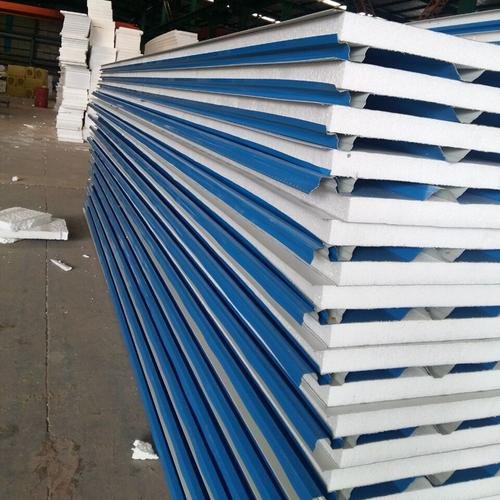
Strong and Long-Lasting
Roof sandwich panels are made to last a long time. They can handle tough weather like strong winds, heavy rain, and extreme heat or cold. This makes them a great choice for hard-to-manage conditions.
Did you know these panels go through strict testing? For example:
Test Name | Purpose |
|---|---|
Long Beam Flexure Test | Checks for cracks or breaks under bending pressure. |
Edgewise Compression Test | Tests how well the edges hold up under pressure. |
Flatwise Tension Test | Measures how strong the bond is between layers. |
Short Beam Shear Test | Checks if the panel can handle sliding forces. |
These tests, along with rules like UL 580 and ASTM E 1592, show that roof panels can survive hurricane winds. They can return to shape after being pressed. With this strength, these panels will protect your building for many years.
Great at Keeping Heat In or Out
Sandwich panels are excellent at keeping buildings comfortable. They block heat in summer and keep warmth inside during winter. This helps lower energy bills and saves money.
Materials like polyurethane (PU) and polyisocyanurate (PIR) are great for insulation. They stop heat from moving through the roof. If you want to save on heating and cooling, these panels are a smart pick.
Resists Water and Moisture
Water damage can ruin buildings, but these panels stop that. Many have special designs to block leaks and keep roofs dry. Even in places with lots of rain, they work well.
This water resistance helps the panels last longer. Whether it’s high humidity or heavy storms, they protect against water problems.
Tip: In rainy areas, use extruded polystyrene (XPS) panels. Their design keeps water out for a long time.
Sound Insulation Properties
Do outside noises bother you at home or work? Roof sandwich panels can help make your space quieter. These panels reduce noise by stopping sound from passing through. Materials like mineral wool and wood fiber are great at absorbing sound. They trap sound waves and stop them from echoing.
For example, mineral wool panels are used in noisy places like factories or airports. They not only keep spaces warm but also block unwanted noise. Wood fiber panels are another option. They are natural, eco-friendly, and good at soundproofing. If you want a peaceful space, these materials are a great choice.
Tip: Live in a loud area? Pick sandwich panels with strong soundproofing. They’ll make your home calm and quiet.
Fire Resistance and Safety
When picking roofing, safety is key. Roof sandwich panels are tested to handle fire and protect buildings. Some materials, like mineral wool, resist fire well. They don’t burn easily and make less smoke, which is safer during emergencies.
Here’s a quick look at fire safety tests for sandwich panels:
Fire Safety Test/Rating | What It Tests For |
|---|---|
BS 476-21 : 1987 | Fire resistance of building materials |
BS EN 1995-1-2 : 2004 | Fire design for timber structures |
EN13501-2:2016 | Fire resistance classification |
EN1365-1:2012 | Fire resistance testing |
Different materials perform differently in fire tests. For example:
Material Type | Fire Growth Rate | Smoke Production | Toxicity Level |
|---|---|---|---|
High | Dense, toxic | High | |
Stone Wool | Low | Light, less toxic | Low |
If fire safety matters most, mineral wool panels are a smart pick. They are safe and reliable.
Lightweight and Easy Installation
Roof sandwich panels are strong but also lightweight. This makes them easy to carry and install. You don’t need big machines or a large team to set them up. A small crew can finish the job quickly, saving time and money.
Here’s why these panels are so easy to use:
Lightweight panels resist weather and hail damage.
Their one-piece design makes installation fast and simple.
They work well for patios, walls, and under decks.
If you want a roofing material that’s easy to install and durable, sandwich panels are a great option. They’re perfect for homes and businesses.
Low Maintenance Requirements
If you want a roof that’s easy to care for, sandwich panels are a great pick. They last a long time and don’t need much upkeep. You won’t have to fix or replace them often, saving both time and money.
These panels are tough against rust, mold, and water damage. Their strong materials and special coatings keep them in good shape, even in bad weather. For example, water-resistant roof panels stop leaks and protect your building from harm. This means less work for you over the years.
Cleaning is super simple. Just rinse with water or use mild soap to keep them clean. Their lightweight design also makes checking and maintaining them easier. Whether it’s for a house or a business, sandwich panels are a low-maintenance choice that works well.
Tip: After storms, check your roof for dirt or leaves. Cleaning it quickly helps keep your panels in great condition.
Aesthetic Versatility
Your roof isn’t just for protection—it also adds style to your building. Sandwich panels give you many choices to create a look you’ll love. Whether you want a modern or classic design, these panels can match your style.
For example:
Metal panels let you create unique designs, even custom 3D shapes.
You can pick coatings in almost any color to make your roof stand out. These coatings also help with insulation.
Standing seam metal sheets offer flexible finishes like PE, HDP, and PVDF. These finishes look great and protect against wear and tear.
Want a roof that stays colorful for years? PVDF coatings keep colors from fading. Choose matte finishes for a soft look or glossy ones for a shiny effect. For instance, the National Museum of the United States Army used over 110,000 square feet of metal panels to create a stunning design. This shows how creative you can get with these panels.
With so many options, sandwich panels let you build a roof that’s both useful and stylish. Whether it’s for your home or a business, you’ll find the perfect fit.
Factors to Think About When Picking Roof Sandwich Panel Materials

Weather and Climate
Think about your area’s weather when picking roofing materials. Some materials work better in certain climates. For example, reflective roofs keep buildings cooler in hot places. Photovoltaic cool roofs mix solar panels with cool coatings. They work well in both summer and winter.
In tough weather, like heavy rain or high humidity, choose materials like extruded polystyrene (XPS) or aluminum skin panels. These materials block water and stop moisture damage. If you live in a fire-prone area, mineral wool panels are a safe choice. They resist fire very well.
Tip: Live where temperatures change a lot? Use polyisocyanurate (PIR). It keeps your home comfy and lasts a long time.
Cost and Budget
Your budget matters when choosing roofing materials. Cheaper options, like asphalt shingles, cost less at first but need replacing often. Expensive materials, like metal roofs, last longer and need less fixing.
Solar roof shingles may cost more upfront but can save money later. You might get a 30% federal tax credit and state benefits. These shingles can also raise your home’s value by $15,000 to $56,000.
Note: Spending more on strong materials now can save repair costs later.
Building Type and Use
The kind of building you have affects your roofing choice. For factories or schools, mineral wool panels are great. They resist fire and block noise. In coastal or wet areas, aluminum skin panels are best. They don’t rust and are flexible for designs.
For homes, you might want a stylish and energy-saving roof. Wood fiber panels look natural and insulate well. Photovoltaic roofs lower energy bills. For cold storage or warehouses, polyisocyanurate (PIR) panels are ideal. They are strong and keep temperatures steady.
Tip: Pick a roofing material that fits your building’s purpose. This ensures it works well for your needs.
Longevity and Warranty
When picking roof sandwich panels, choose ones that last long. Long-lasting materials save money and reduce frequent replacements. Roof panels are made to handle bad weather, but their lifespan depends on the material.
Here’s a simple comparison of how long they last and their warranties:
Roofing Material | Average Lifespan | Warranty Duration |
|---|---|---|
Metal Roofs | 30 years | |
Asphalt Shingles | 15-20 years | 30 years |
Metal roofs can last more than 30 years, making them dependable. Asphalt shingles cost less but may need replacing sooner. Both often come with warranties matching their lifespan. This ensures your investment is safe.
Always check the warranty when buying roof panels. A good warranty covers defects and performance in tough weather. This keeps your roof strong and reliable for many years.
Environmental Impact and Sustainability
Roof sandwich panels are useful and can also be eco-friendly. Many are made to help the environment while protecting your building.
Here’s how these panels help the planet:
Aspect | Example |
|---|---|
Energy Efficiency | PIR/PUR panels lower energy use by insulating buildings. |
Recyclability | Metal and core materials can be recycled to reduce waste. |
Minimal Material Waste | Panels are cut to size, so there’s little waste during setup. |
Quick Assembly | Lightweight panels need less machinery, cutting emissions. |
Durability | Strong panels last long, though it depends on conditions. |
For instance, PIR and PUR panels keep buildings insulated, reducing heating or cooling needs. This saves energy. Many panels are recyclable, so they don’t fill up landfills. Their light design means fewer machines are needed for installation, lowering pollution.
By choosing eco-friendly panels, you protect your building and the planet. It’s a smart and green choice!
Picking the best roof sandwich panel material is important. Polyurethane panels save energy and stop heat from escaping. Mineral wool panels are great because they resist fire. Extruded polystyrene panels work well in wet weather and block water.
It’s a good idea to hire experts for installation. Professionals make sure the roof is set up correctly. This avoids problems like leaks or damage. For example:
One study showed experts stopped leaks and kept things running.
Another project found bad setup caused rainwater issues, proving expert help matters.
With the right material and skilled help, your roof will last long, save energy, and handle tough weather.
FAQ
What is the best roof sandwich panel material for hot climates?
Polyisocyanurate (PIR) panels are great for hot places. They insulate well, keeping buildings cool and saving energy. PIR panels reflect heat, making them perfect for high-temperature areas.
Are roof sandwich panels eco-friendly?
Yes, many are eco-friendly. Mineral wool and wood fiber use recycled or natural materials. Panels like PIR and PU save energy, helping lower your carbon footprint.
How long do roof sandwich panels last?
Most panels last 20-30 years or longer with good care. Metal panels often last the longest. Regular maintenance can help extend their life even more.
Can sandwich panels handle heavy rain?
Yes, they can! Extruded polystyrene (XPS) panels resist water and moisture. Their special design keeps water out, making them great for wet or humid areas.
Do roof sandwich panels reduce noise?
Yes, they do! Mineral wool and wood fiber absorb sound well. These panels are ideal for noisy areas, creating a quieter indoor space.
Tip: For the best soundproofing, pick panels made for noise control.

